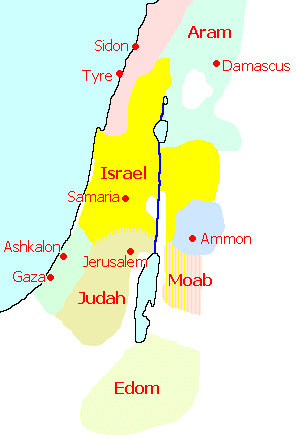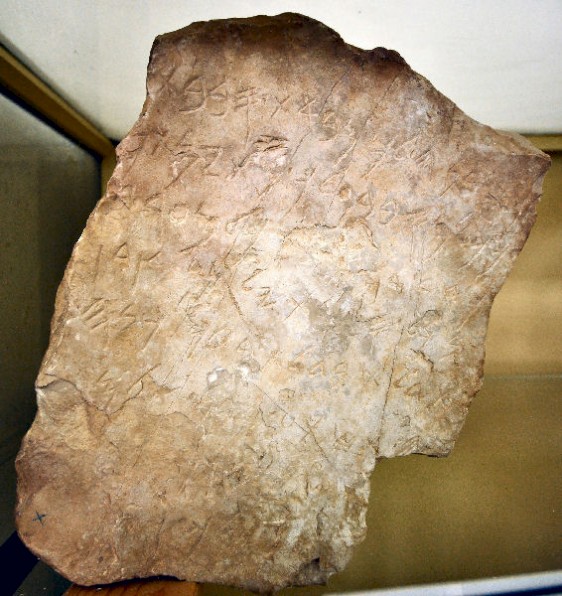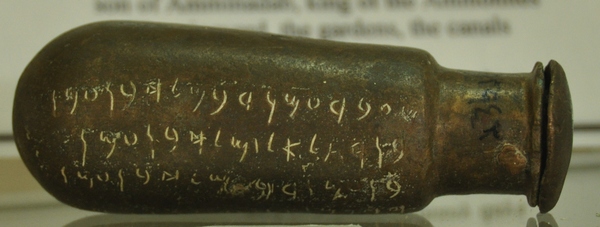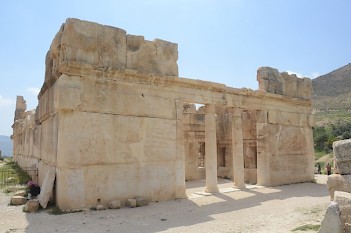Ammon (kingdom)
Q473433Ammon: Bronze and Iron Age kingdom, east of the river Jordan.

According to the Biblical book of Judges,note the land of "the children of Ammon" (b'ne Ammon) was situated "from Arnon unto Jabbok, and unto Jordan". We might add that the eastern border was the desert, that the words "children of..." probably indicate the (semi)tribal nature of Ammonite society, and that it was the northernmost of three Iron Age nations east of the river Jordan; the others were Moab and Edom.
The country makes its first appearance in our sources in the book of Numbers,note where we read that an Amorite leader named Sihon occupied a place called Hesbon, in the western border zone between the Moabites and Ammonites. Another Amorite leader, Og, had occupied another part of this land. They were defeated by the Hebrews, led by Moses, who now settled in this area.note Later, we find that this land was occupied by the tribes of Reuben and Gad.note The majority of the Hebrews proceeded to settle on the west bank of the river Jordan.

The book of Judges makes it clear that possession of Hesbon remained contested. The Hebrews claimed that it was theirs, because they had conquered it, while the Ammonites claimed it had always been theirs.note Although the Ammonites invaded the land of Israel,note they were defeated by Jephta. Later, the Jewish king Saul celebrated a victory at Jabes,note while king David and his general Joab defeated the Ammonite leader Hanun.note He proceeded to capture the main settlement of the Ammonites, Rabbath-Ammon (modern Amman), and united the two states in a personal union.note His successor, Solomon (r.c.970-c.931), married to an Ammonite woman, Naamah, who was mother of his successor, king Rehoboam of Judah (r.931-913).
How much of the Biblical account is true, we do not know, because there is almost no independent confirmation (although David is a historical person). Yet, these were unquiet times indeed, as is proved by the Iron Age watchtowers that were in this age erected in the land of the Ammonites. (An example is Rujm al-Malfouf.)

After the reign of Solomon, the Ammonites became independent - apparently, they did not reckon king Rehoboam as one of theirs. This was also the age in which Ammon became a state, which, archaeologically speaking, means (among other things) that there is evidence for writing. An inscription from the citadel of modern Ammon mentions the supreme god Milkomnote as ordering a city wall:
Words of Milkom: build for yourself entrances roundabout [...
...] that all who surround you shall surely die [...
...] I shall surely destroy. All who enter [...
...] and amid its columns the just will reside [...
...] the innermost door [I shall surely] extinguish [...
...] you shall gaze in awe in the midst of the porch [...
...] and [unintelligible] [...
...] peace to you and pe[ace to your descendants.]
Another indication that Ammon had become a real state, is the presence of Ammonite troops during the battle of Qarqar (853 BCE), in which a coalition of Levantine states repulsed the Assyrian king Šalmaneser III. The commander of the Ammonites was king Baasha.
In 733, the Ammonite king Sanipu is mentioned as paying tribute to the Assyrian king Tiglath-pileser III (r.745-727), and his successor Pudu-il is mentioned as vassal king during the reigns of Sennacherib (705-681) and Esarhaddon (680-669). Either Sanipu or Pudu-il took over the Israelite countries east of the river Jordan.note The Ammonite king Amminadab I was a contemporary of Aššurbanipal (669-631?), while his son Hissa'il and his grandson Amminadab II are mentioned in a brief text written on a metal bottle from Tell Siran, made in c.600 BCE.
May the produce of Amminadab, king of the Ammonites,
son of Hissa'il, king of the Ammonites,
son of Amminadab, king of the Ammonites,
from the vineyards and the gardens and the hollow and the cistern,
cause joy and gladness for many days to come and years far off.

As an Assyrian vassal, Ammon had retained some of its independence, but when the Assyrians had been superseded by the Babylonians as leaders of the Near East, Ammon and Moab were, in 582, reduced to the rank of province of the Babylonian Empire.note Judah had already been annexed in 587.
The country's history was now identical to that of the Near Eastern empire: when the Persians took power in 539, they also became the new masters of the province of Ammon. A very brief inscription from the theater of Amman shows that, in spite of several regime changes, the Ammonites maintained ancestral traditions: they used the ancient title ba'al, "lord", for one of their gods and still called themselves "son of Ammon":
... for] Ba'al I shall build [...
...] son of Ammon [...

When the Macedonian conqueror Alexander the Great subdued the Persians after 334 BCE, he took over Ammon as well. After his death and after the civil wars at the end of the fourth century, the region was part of the Ptolemaic Empire. In the third century, Ammon was renamed Philadelphia (after king Ptolemy II Philadelphus, r.282-246).
The leading Ammonite family was that of the Tobiads, who were Jewish. Their palace has been identified at Qasr al-Abd (halfway between Amman and the Dead Sea). They continued to play an important role until the Seleucids conquered the region.